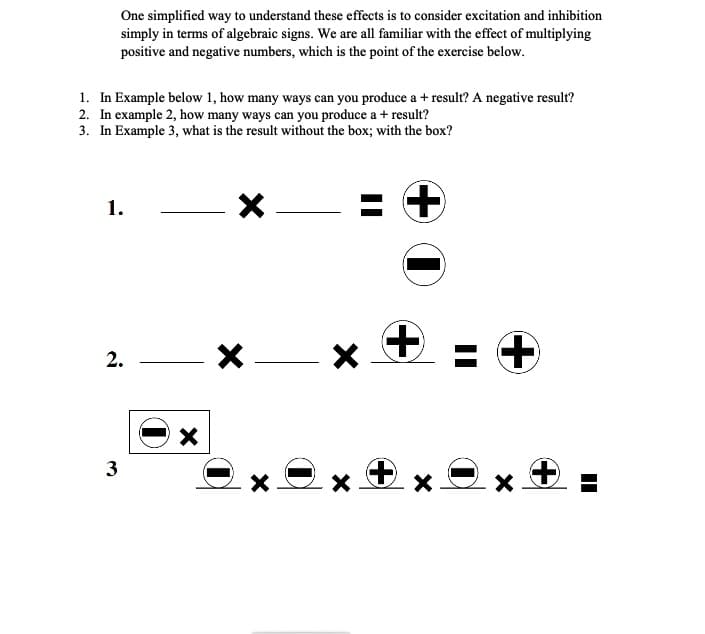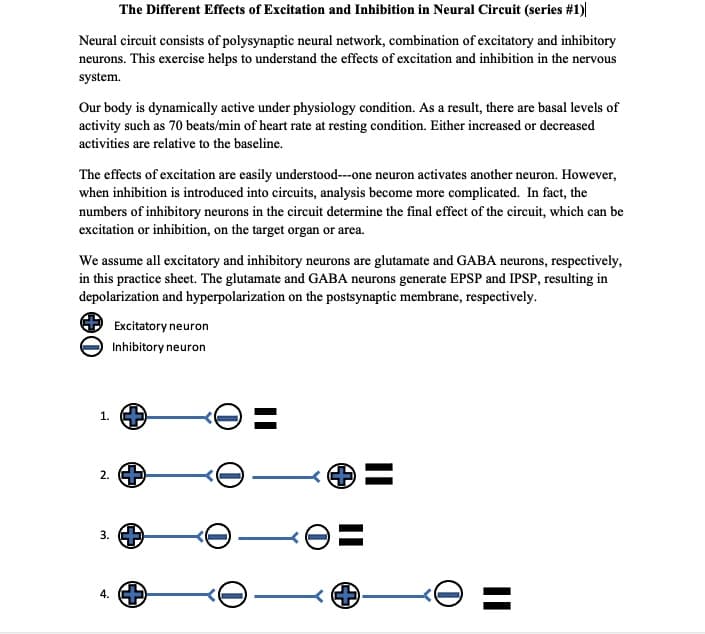One simplified way to understand these effects is to consider excitation and inhibition simply in terms of algebraic signs. We are all familiar with the effect of multiplying positive and negative numbers, which is the point of the exercise below. 1. In Example below 1, how many ways can you produce a + result? A negative result? 2. In example 2, how many ways can you produce a + result? 3. In Example 3, what is the result without the box; with the box? 1. x + = + 3 2.
One simplified way to understand these effects is to consider excitation and inhibition simply in terms of algebraic signs. We are all familiar with the effect of multiplying positive and negative numbers, which is the point of the exercise below. 1. In Example below 1, how many ways can you produce a + result? A negative result? 2. In example 2, how many ways can you produce a + result? 3. In Example 3, what is the result without the box; with the box? 1. x + = + 3 2.
Linear Algebra: A Modern Introduction
4th Edition
ISBN:9781285463247
Author:David Poole
Publisher:David Poole
Chapter4: Eigenvalues And Eigenvectors
Section4.6: Applications And The Perron-frobenius Theorem
Problem 70EQ
Related questions
Question

Transcribed Image Text:One simplified way to understand these effects is to consider excitation and inhibition
simply in terms of algebraic signs. We are all familiar with the effect of multiplying
positive and negative numbers, which is the point of the exercise below.
1. In Example below 1, how many ways can you produce a + result? A negative result?
2. In example 2, how many ways can you produce a + result?
3. In Example 3, what is the result without the box; with the box?
1.
x + = +
3
2.

Transcribed Image Text:The Different Effects of Excitation and Inhibition in Neural Circuit (series #1)|
Neural circuit consists of polysynaptic neural network, combination of excitatory and inhibitory
neurons. This exercise helps to understand the effects of excitation and inhibition in the nervous
system.
Our body is dynamically active under physiology condition. As a result, there are basal levels of
activity such as 70 beats/min of heart rate at resting condition. Either increased or decreased
activities are relative to the baseline.
The effects of excitation are easily understood---one neuron activates another neuron. However,
when inhibition is introduced into circuits, analysis become more complicated. In fact, the
numbers of inhibitory neurons in the circuit determine the final effect of the circuit, which can be
excitation or inhibition, on the target organ or area.
We assume all excitatory and inhibitory neurons are glutamate and GABA neurons, respectively,
in this practice sheet. The glutamate and GABA neurons generate EPSP and IPSP, resulting in
depolarization and hyperpolarization on the postsynaptic membrane, respectively.
Excitatory neuron
Inhibitory neuron
1.
2.
3.
4.
Expert Solution
This question has been solved!
Explore an expertly crafted, step-by-step solution for a thorough understanding of key concepts.
Step by step
Solved in 2 steps

Recommended textbooks for you

Linear Algebra: A Modern Introduction
Algebra
ISBN:
9781285463247
Author:
David Poole
Publisher:
Cengage Learning

College Algebra (MindTap Course List)
Algebra
ISBN:
9781305652231
Author:
R. David Gustafson, Jeff Hughes
Publisher:
Cengage Learning

Trigonometry (MindTap Course List)
Trigonometry
ISBN:
9781337278461
Author:
Ron Larson
Publisher:
Cengage Learning

Linear Algebra: A Modern Introduction
Algebra
ISBN:
9781285463247
Author:
David Poole
Publisher:
Cengage Learning

College Algebra (MindTap Course List)
Algebra
ISBN:
9781305652231
Author:
R. David Gustafson, Jeff Hughes
Publisher:
Cengage Learning

Trigonometry (MindTap Course List)
Trigonometry
ISBN:
9781337278461
Author:
Ron Larson
Publisher:
Cengage Learning